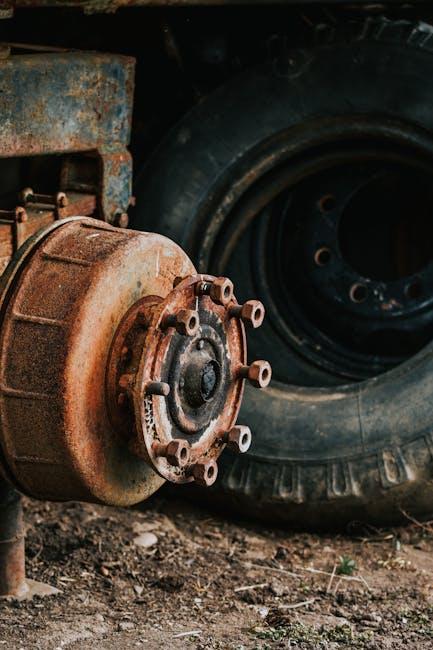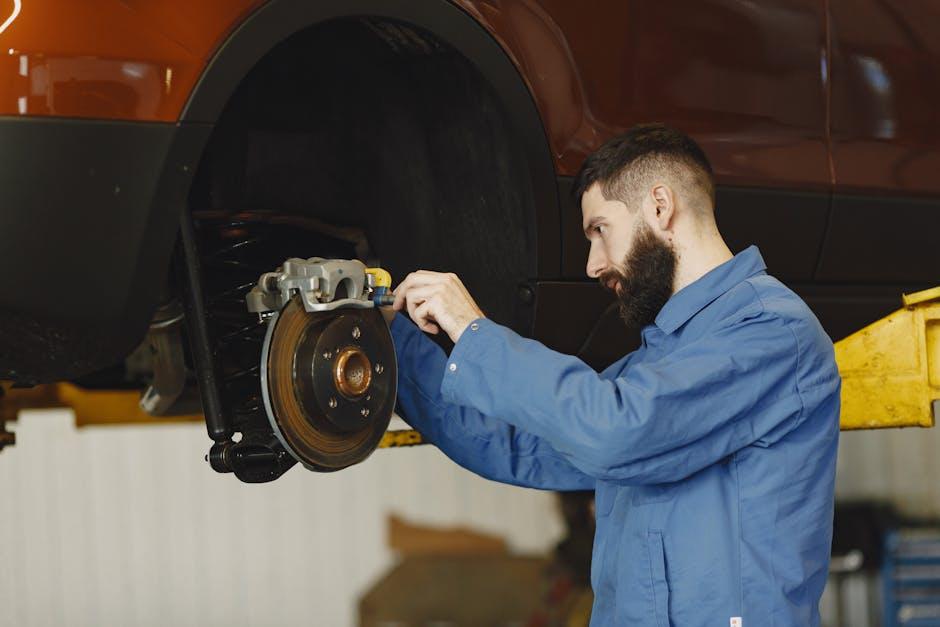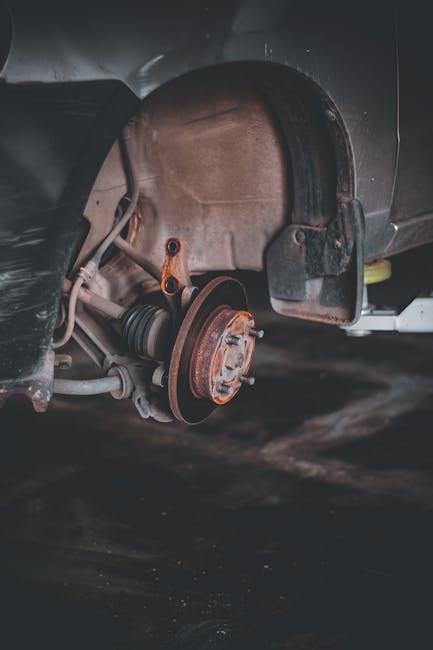As vehicles age, their once-trusty components begin to show signs of wear and tear, and few parts are as crucial—or as vulnerable—as the braking system. In older cars, a combination of time, mileage, and environmental factors can conspire to compromise brake performance, sometimes subtly, sometimes alarmingly. Understanding the common brake problems that tend to plague aging vehicles not only helps drivers maintain safety on the road but also offers insights into timely maintenance and repair. In this article, we delve into the typical challenges faced by older braking systems, exploring why they occur and how to recognize the warning signs before they escalate into serious issues.
Table of Contents
- Common Signs of Brake Wear in Aging Cars
- Understanding Brake Fluid Contamination and Its Effects
- The Impact of Rust and Corrosion on Brake Performance
- Addressing Worn Brake Pads and Rotors for Safer Driving
- Preventive Maintenance Tips to Extend Brake System Life
- When to Consult a Professional for Brake Repairs
- Q&A
- Closing Remarks

Common Signs of Brake Wear in Aging Cars
As vehicles age, the efficiency of their braking systems can diminish, revealing several telltale symptoms that shouldn’t be ignored. One of the most noticeable indications is a squealing or grinding noise when the brakes are applied. This often signals worn brake pads or rotors that need timely replacement to avoid more costly repairs. Additionally, experiencing vibrations or pulsations through the brake pedal can mean the brake discs are warped or uneven, a common issue in older cars subjected to varied road conditions.
Paying close attention to other subtle signs can also save you from unexpected brake failure. Look out for:
- Increased stopping distances – brakes that require more room to stop indicate pad thinning or fluid issues.
- Soft or spongy brake pedal – often caused by air in the brake lines or worn-out components.
- Brake warning lights on the dashboard – an electronic signal that alerts you to a problem within the braking system.
| Symptom | Possible Cause | Recommended Solution |
|---|---|---|
| Squealing Noise | Worn Brake Pads | Replace Pads |
| Brake Pedal Vibrations | Warped Rotors | Resurface or Replace Rotors |
| Soft Brake Pedal | Air in Brake Lines | Brake System Bleed |
| Brake Warning Light | Various Sensor Alerts | Diagnostic Check |

Understanding Brake Fluid Contamination and Its Effects
Brake fluid contamination is a silent threat that severely compromises the safety and efficiency of your braking system. Over time, brake fluid can absorb moisture from the air, leading to a decrease in its boiling point. This moisture buildup not only causes corrosion inside the brake lines and calipers but also results in a spongy brake pedal feel, reduced responsiveness, and increased stopping distances. Older vehicles, in particular, are vulnerable because the brake fluid is often neglected during routine maintenance, allowing contaminants like dirt, rust, and even small air bubbles to accumulate unnoticed.
Common indicators of brake fluid contamination include:
- Soft or sinking brake pedal
- Brake warning light activation
- Unusual noise during braking
- Visible discoloration or murkiness in the fluid reservoir
| Contaminant | Effect on Braking | Recommended Action |
|---|---|---|
| Water | Reduced boiling point, vapor lock | Flush and replace fluid |
| Dirt/Rust | Blockages, corrosion | Clean system, replace components |
| Air Bubbles | Spongy pedal response | Bleed brake lines |

The Impact of Rust and Corrosion on Brake Performance
Rust and corrosion silently degrade brake components, often rendering them less effective over time. When rust forms on brake rotors or drums, it creates an uneven surface that can cause vibrations and reduce the contact area between the brake pads and rotors, leading to longer stopping distances. Corrosion on brake lines can also cause leaks, risking brake fluid loss and potential brake failure. This degradation isn’t always visible at first glance, but its effects can manifest as squealing noises, reduced responsiveness, or a spongy brake pedal feel.
Key consequences of rust and corrosion include:
- Uneven wear on brake pads
- Reduced braking efficiency
- Increased stopping distances
- Potential brake fluid leaks
- Squeaking or grinding noises
| Component | Common Rust Effect | Impact on Performance |
|---|---|---|
| Rotors/Drums | Surface pitting | Brake judder & vibration |
| Brake Pads | Uneven wear | Reduced grip & noise |
| Brake Lines | Corrosion leaks | Fluid loss & failure risk |

Addressing Worn Brake Pads and Rotors for Safer Driving
When brake pads and rotors show signs of wear, the safety of your driving experience can be seriously compromised. Recognizing the subtle warnings—such as a squeaking noise, reduced braking response, or a pulsation in the brake pedal—can prevent costly repairs and dangerous situations on the road. Addressing these issues promptly means prioritizing your safety and maintaining the smooth, confident control of your vehicle.
Key steps to effectively manage worn brake components include:
- Regular Inspections: Schedule brake checks every 10,000 miles or sooner if symptoms arise.
- Replacing Brake Pads: Opt for quality replacements that match your vehicle’s specifications to ensure longevity and performance.
- Resurfacing or Replacing Rotors: Depending on the rotor’s condition, it might need smoothing or a full replacement to prevent vibration and uneven wear.
| Component | Signs of Wear | Recommended Action |
|---|---|---|
| Brake Pads | Squealing, reduced stopping power | Replace promptly |
| Brake Rotors | Vibration, grooves | Resurface or replace |

Preventive Maintenance Tips to Extend Brake System Life
Maintaining an older vehicle’s brake system involves proactive care to prevent wear and costly repairs. Regularly checking brake fluid levels and ensuring they are topped up with the correct type helps maintain hydraulic pressure. It’s equally important to inspect brake pads and rotors for uneven wear or signs of cracking—replacing components before they fail boosts safety and performance. Simple habits, such as avoiding harsh braking and giving some time for brakes to cool after heavy use, significantly reduce thermal stress on the system.
Consistency in maintenance can also be supported by a practical checklist like the one below, which covers essential tasks and recommended intervals:
| Maintenance Task | Frequency | Benefit |
|---|---|---|
| Brake fluid check and replacement | Every 2 years | Ensures optimal hydraulic function |
| Brake pad inspection | Every 10,000 miles | Prevents premature wear and noise |
| Rotor surface cleaning | During pad replacement | Maintains smooth braking action |
Additional Tips:
- Store vehicles in dry areas to avoid corrosion on brake components.
- Periodically pump the brakes after long storage periods to ensure responsiveness.
- Use dust covers to protect brake calipers from debris buildup.

When to Consult a Professional for Brake Repairs
When your brakes begin to exhibit persistent issues such as grinding noises, a soft brake pedal, or noticeable vibrations while stopping, it’s a clear signal that professional intervention is necessary. Attempting to diagnose and fix these symptoms without proper expertise can lead to overlooked damage or improper repairs, which might jeopardize your safety on the road. Additionally, if you notice uneven brake wear or your vehicle pulls to one side during braking, these subtle signs underscore the importance of expert inspection.
Regular maintenance is crucial, but certain situations call for immediate professional attention:
- Brake warning light illuminated on the dashboard
- Unusual smells like burning rubber or brake fluid leakage
- Excessive stopping distance despite normal pedal feel
- Historical neglect or irregular brake servicing
| Symptom | Possible Cause | Why an Expert is Needed |
|---|---|---|
| Grinding Sounds | Worn Brake Pads | To prevent rotor damage and ensure proper replacement |
| Soft Pedal | Brake Fluid Leak or Air in Lines | Requires careful bleeding and leak repair |
| Vehicle Pulls | Uneven Pad Wear or Caliper Issues | Needs precise alignment and part replacement |
Q&A
Q&A: Common Brake Problems in Older Vehicles
Q1: Why do brakes in older vehicles tend to fail more often than newer models?
A1: Over time, brake components undergo wear and tear due to constant use and exposure to elements like moisture, dust, and road salt. Older vehicles may also lack advanced materials and technologies found in newer models that enhance brake durability and performance, making them more susceptible to issues.
Q2: What are the most common brake problems seen in older cars?
A2: Typical problems include worn brake pads, warped rotors, brake fluid leaks, corroded brake lines, and sticking calipers. These issues can result from prolonged use and neglect, leading to decreased braking efficiency and increased stopping distances.
Q3: How can I tell if my older vehicle’s brakes need attention?
A3: Warning signs include squealing or grinding noises when braking, a soft or spongy brake pedal, longer stopping distances, vibrations or pulsations felt through the brake pedal, and brake warning lights on the dashboard. Any of these symptoms should prompt an inspection.
Q4: Can regular maintenance help prevent brake problems in older vehicles?
A4: Absolutely. Routine inspections, timely replacement of brake pads and fluid, and addressing minor issues before they escalate can significantly prolong brake system life and improve safety.
Q5: Are there any unique challenges when repairing brakes on older vehicles?
A5: Yes. Older models may have outdated parts that are harder to find, and corrosion or wear can complicate repairs. Additionally, older brake systems might not be compatible with modern hardware, requiring careful selection of replacement components.
Q6: Is it worth upgrading the brake system on an older vehicle?
A6: Upgrading can enhance braking performance and safety, especially if the car is driven in demanding conditions. However, it’s important to balance cost, compatibility, and the intended use of the vehicle before making modifications.
Q7: What’s the best advice for owners of older vehicles regarding brake care?
A7: Stay proactive. Regularly inspect your brakes, replace worn components promptly, maintain brake fluid quality, and consult a trusted mechanic familiar with older vehicles. Preventative care is key to safe and reliable stopping power regardless of your car’s age.
Closing Remarks
As the miles add up and years roll by, older vehicles often carry the stories of countless journeys—each brake squeal or pedal sponginess a subtle reminder that time takes its toll. Understanding common brake problems not only helps preserve safety but also honors the legacy of these trusted machines. Whether it’s a simple fix or a call for professional care, staying attentive to brake health ensures that every ride, old or new, remains a journey traveled with confidence and peace of mind. After all, when it comes to brakes, a little knowledge can go a long, safe way.
